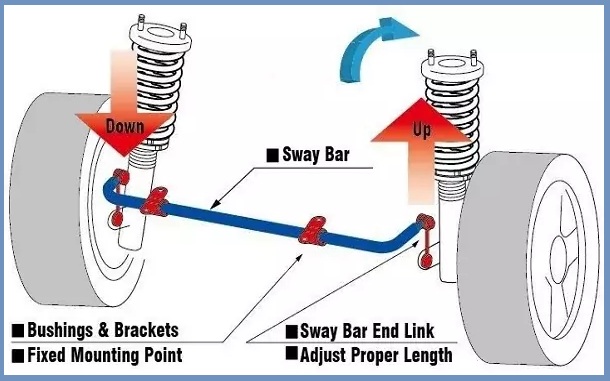The sway bar is also known as or anti-roll bar. It is part of the vehicle suspension system that connects the opposite side (right / left) of the rear or front suspension. It reduces the vehicle’s pitch during fast turns. It is a durable piece of tubular steel. The anti-roll bar link is a connector that connects the outer end of the anti-roll bar to the suspension system and helps hold the wheel control arm. The length of these bars ranges from 4 to 6 inches but may vary by vehicle model. These links are connected to the stabilizer bar at a 90° angle. The largest vehicles have small ball joints at both ends of these links.

The main function of the stabilizer is to stop excessive body roll and stabilize the vehicle when turning. Most cars have two anti-roll bars.
- Front suspension stabilizer bar
- Another anti-roll bar on the rear suspension
Some special vehicle types include only one anti-roll bar in the front suspension. Sports cars have a thick stabilizer bar for added stability when turning. Use a rubber bushing to connect the anti-roll bar or anti-roll bar to the car body or center frame. The outer edge of this rod connects to the vehicle’s suspension component that holds the wheel.
Table of Contents
How does it Work?
Sway bars are used to prevent the vehicle from rolling over. This rod is connected to each front wheel of the vehicle. This is a U-shaped steel bar.

If you turn the car while driving, the weight of the car and the car body will move to one side. When the body moves to one side, the car experiences “rocking” or “rolling”.
When you turn the car, your body shakes and you get off the corner. This transfers most of the weight of the vehicle to the outer wheels and compresses the suspension of the two outer rings.
During this curve, the wheels inside the curve go up or the suspension of the wheels inside the curve stretches.
Let’s use a simple example to explain when you bend quickly, when your body bends, or when you pull from a corner. In the next corner, think about how your body feels when you shake and your car experiences the same thing.
The anti-roll bar is responsible for controlling this body roll. Push the tires inside the turndown and compress the inner wheel suspension to maintain road contact and ensure vehicle stability.
The anti-roll bar evenly distributes the weight of the vehicle across all four tires, making the vehicle as stable as possible when cornering.
The Function of Sway Bar
The first function of the anti-roll bar is to reduce the tilt of the car body. The reduction in body roll or pitch depends on the overall roll stiffness of the vehicle. Increasing the overall lean stiffness of the vehicle does not change the steady-state transmission of the gross weight (load) from the inner ring to the outer ring. It just reduces body roll. The width of the truck and the height of the center of gravity are used to determine the total lateral weight transfer.
Another function of the anti-roll bar is to adjust the driving balance of the vehicle. The phenomenon of oversteer or understeer can be adjusted by changing the overall roll stiffness ratio of the rear and front axles. Increasing the roll stiffness ratio of the front wheels increases the overall load transfer ratio that the front axle responds to, reducing the responsiveness of the rear axle. This generally causes the outer front wheels to rotate at a relatively high slip angle and the outer rear wheels to rotate at a relatively low slip angle. Increasing the roll stiffness ratio of the rear axle has the opposite effect and reduces understeer.
Importance of Sway Bar in a Vehicle
Anti-roll bars are most commonly used in vehicles to ensure safety. This beam can be dangerous if the car is turned over too much.
It also helps prevent the vehicle from slipping in corners. As a result, the anti-roll bar prevents the wheels from losing traction and can cause the driver to slip. This makes the vehicle more difficult to control, especially when braking and cornering.
However, the anti-roll bar does not apply to all vehicles, so it has many drawbacks. Too stiff stabilizer bars are one of the main symptoms of poor stabilizer linkage. This makes the whole vehicle feel stiff when navigating the bumps. If it is too stiff, the bike is more likely to hang.
A rigid sway bar is most commonly used in vehicles that can generate high steering forces on flat roads (such as race cars and high-performance sports cars such as the Dodge Charger and Ford Mustang). .. These cars are designed for high speed driving on flat roads. Therefore, the front and rear bars will be thicker. As a result, the stiffer anti-roll bars allow these cars to turn sharply, reducing the risk of the vehicle losing grip on the road and floating in the air.
